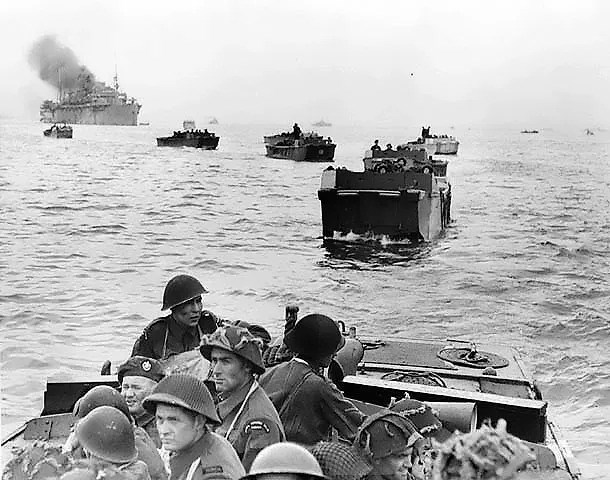The success of the Allied invasion of Normandy, France, during the Second World War can be attributed to the contributions — and sacrifices — of thousands of soldiers, sailors and airmen before, during and after the battle.
Nearly 150,000 Allied troops participated in D-Day 79 years ago on June 6, 1944, including 14,000 Canadian soldiers landing on Juno Beach. The Royal Canadian Navy contributed 110 ships and 10,000 sailors and the Royal Canadian Air Force (RCAF) contributed 15 fighter and fighter-bomber squadrons.
Total Allied casualties were more than 14,000, including 1,074 Canadians, of whom 359 were killed. By the end of the Battle of Normandy on Aug. 21, the Allies had suffered 209,000 casualties, including more than 18,700 Canadians, of whom over 5,000 were killed.
Air attacks
Allied air forces began attacking German targets in France in the months leading up to the invasion.
One such airman was Warrant Officer Francis Basil Dennis, who served in 427 Squadron.
The pilot was born on March 12, 1924, to parents John Basil and Helen Myrtle (Irvin) and lived at 1191 First Avenue Northeast. He was single, a Roman Catholic, and worked for the Canadian Pacific Railway.
Dennis was one of seven airmen flying in a Halifax bomber to attack a train yard in France on April 18, 1944. They took off from their airbase at 8:50 p.m. but were never heard from again.
The military was unable to establish a cause for their loss but knew the plane crashed in the target area.
Dennis was 20 when he died and was buried in Clichy, a town near Paris.
A tragic end
Another Moose Javian who gave his life was Flying Officer Richard Gainford Askew, who flew with 69 Squadron.
Askew was born in Briercrest on March 12, 1923, to Edward and Mary Agnes (Black) and was the brother to William, John and Dorothy. After his mother died in the 1930s, the family moved to 511 Ominica Street East.
The boy was 5-6 in height, weighed 135 pounds, and had blue eyes and brown hair. He was also single, an Anglican and worked as a laboratory assistant with the British American Oil Company when he enlisted on Oct. 10, 1942, at age 19.
Askew was one of eight airmen flying in a Wellington bomber during an attack over Lisieux, France, on July 25, 1944. At some point, the plane was shot down and the Moose Javian was one of four members killed.
They were initially listed as missing before the air force declared them “presumed dead.” Residents buried the men in the Bayeux War Cemetery, 24 kilometres northwest of Caen, a city where Canadians were engaged in heavy fighting.
Bayeux was the first French town of importance that the Canadians liberated from the Germans in June 1944. A monument was later erected to honour the 1,803 soldiers with no known grave who died fighting in Normandy.
Ground attack
A soldier who died during the Battle of Normandy was Lt. Charles Douglas Grayson Jr., who was serving with the South Saskatchewan Regiment (SSR).
He was born on March 12, 1920, to Charles Douglas and Retta May of 138 Hochelaga Street East. He was single, stood 6-1, was 165 pounds and had blue eyes and fair hair. He was working for Blackwood Hardware as a salesman and warehouse manager when he enlisted on July 18, 1940.
Grayson was killed on July 20, 1944, at age 24. He was buried at the Brettville-sur-Laize Canadian War Cemetery near Calvados, France.
A family mourns
Another soldier killed was Capt. Aubrey Conrad Cawsey, who was with the King’s Own Rifles of Canada but was serving with the British Army’s 5th Battalion South Staffordshire Regiment as a CANLOAN officer.
The man was born in 1912 to Frederick Lewis and Barbara Jean at 1219 Redland Avenue, and had three brothers, Benjamin, Emery and Ralph; the latter two served in the war.
He attended King George Public School and Central Collegiate Institute while he worked with the Canadian Pacific Railway, the T. Eaton Company Limited, and Slater and York.
Cawsey later married Kathleen Elizabeth Baylis and they had a daughter, Joan, 3 ½, and a son, Thomas Frederick, 1.
According to the online Wartime Memories Project, Cawsey went overseas with the Saskatoon Light Infantry Regiment in 1940 as a lieutenant and was promoted to captain. He was recalled to Canada in 1942 and joined the King’s Own Rifles of Canada after the first battalion was mobilized.
He took a course at the Royal Military College in Kingston, Ont., graduating as a major, but relinquished that title to return overseas. He eventually landed in France on June 13, 1944, and immediately entered battle.
In a letter to his parents dated July 24, 1944, Cawsey spoke hopefully of the war’s end and rejoining his wife and family.
On Aug. 7, 1944, at age 32, Cawsey was killed in action and buried at Ryes War Cemetery in Calvados, France.
The battle’s end
Meanwhile, Sgt. Ronald Edward Jinks was killed several days before the Battle of Normandy finished.
Jinks was born on May 17, 1922, to William and Elizabeth of 1319 Grafton Avenue. His brothers were William Alfred and James Albert; they later joined the Royal Canadian Navy.
He stood 5-11, weighed 160 pounds, was Anglican, had worked for the Regina Leader-Post for nearly three years in circulation and as a carrier, and was a student when he enlisted on Jan. 23, 1942. He also enjoyed baseball and hockey and could play the mouth organ.
“He seems eager and well-adjusted to army life. He has ambitions for promotion,” his records say. “A move to a higher rank is doubtful unless experience and a quality of leadership would warrant it.”
Jinks, 22, was serving with the 1st Battalion of the Canadian Scottish Regiment attempting to capture a German army group when he was killed on Aug. 15, 1944. He was later buried in Brettville-sur-Laize Cemetery.




